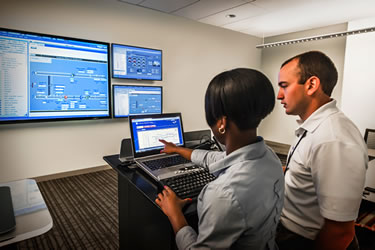Many high-rise facilities have evolved to become multi-function, multi-tenant spaces where tenants can live, work, and shop all in one building. Managing a large space can be a challenge when trying to provide a comfortable environment while maximizing energy efficiency and keeping building costs low.
The balance between happy tenants and reasonable costs can be met with the help of smart technology that anticipates problems in buildings, allowing the facility manager to correct them long before there is a significant decline in efficiency due to wasteful operation (or a systems failure altogether).

Dashboards can be used as a tool to analyze and display discrepancies between normal baseline consumption and actual energy usage, helping to highlight areas that require attention.
Building managers need to be both strategic and tactical planners; smarter buildings have allowed them to do that. Building technology has streamlined and organized the way facilities professionals operate nearly every building system by providing the ability to immediately translate important data and use it to generate more achievable efficiencies.
This process creates ease of functionality by providing visual dashboards that ensure systems are running well with just a quick glance. This same technology also quickly flags and isolates potential problem areas, pinpointing where to focus attention to correct any issues.
Depending on tenant space, facilities managers may need to manage energy consumption tightly to make sure tenants are operating within set limits. Dashboards can be used as a tool to analyze and display discrepancies between normal baseline consumption and actual energy usage, helping to highlight areas that require attention. Faults can be automatically generated to alert the appropriate person when tenants are reaching a set threshold of energy consumption. That way, adjustments can be made to curb usage before it’s too late.
Some building efficiency systems or apps allow facilities managers to see exactly what their building automation systems see 24/7. These systems keep you apprised of problems that may waste energy and impact the comfort of building occupants. They also help optimize system performance, save money and energy, and more accurately predict and prioritize future maintenance needs.
Measurable Results
Western Kentucky University staff members turned to a building management and efficiency system to improve the performance and energy efficiency of their campus, including the 27-story Pearce Ford Tower residence hall. Not only do these platforms collect and manage building system and equipment information, but they also analyze and present data that can be accessed on electronic devices and smartphones. Adding a building efficiency platform to the building management system (BMS) equation takes them one step further, allowing facilities professionals to review, prioritize, and act on the data being captured by a BES.
In just six months, Western Kentucky University recouped its investment in the building efficiency platform by using it to correct system faults that were wasting energy on campus. These faults were going unnoticed because they weren’t accompanied by a complaint. Savings are now being reinvested in new initiatives and equipment; for example, savings were used to purchase two natural gas boilers that replaced older, inefficient boilers.
Before implementing the platform, Western Kentucky University was experiencing equipment inefficiency; as a result, the campus was wasting energy in ways staff members weren’t even aware of. After introducing the building efficiency system, however, facilities staff members can now easily analyze and interpret data to find opportunities for efficiency and optimization.
Investing in Smart Buildings
With most building owners expecting a maximum return on their investment, building automation and building efficiency systems can help ensure that all of your building systems – HVAC, lighting, fire safety, security, and other equipment – operate together. Through building efficiency system dashboards, existing data can be presented in the most organized and informative way possible through customizable reports that help facilities professionals get a better handle on energy strategies.
Mark Hendrickson
Mark Hendrickson is the director of installation support and customer service for Panoptix, Johnson Controls’ smart building energy management platform.

